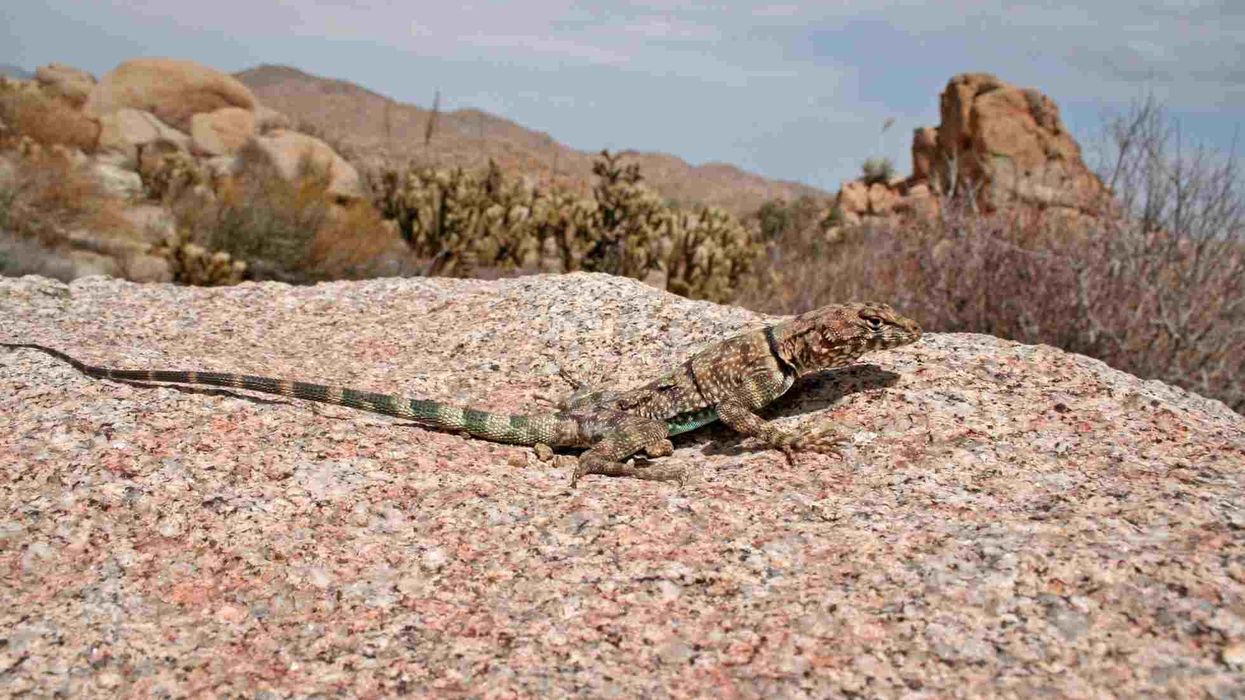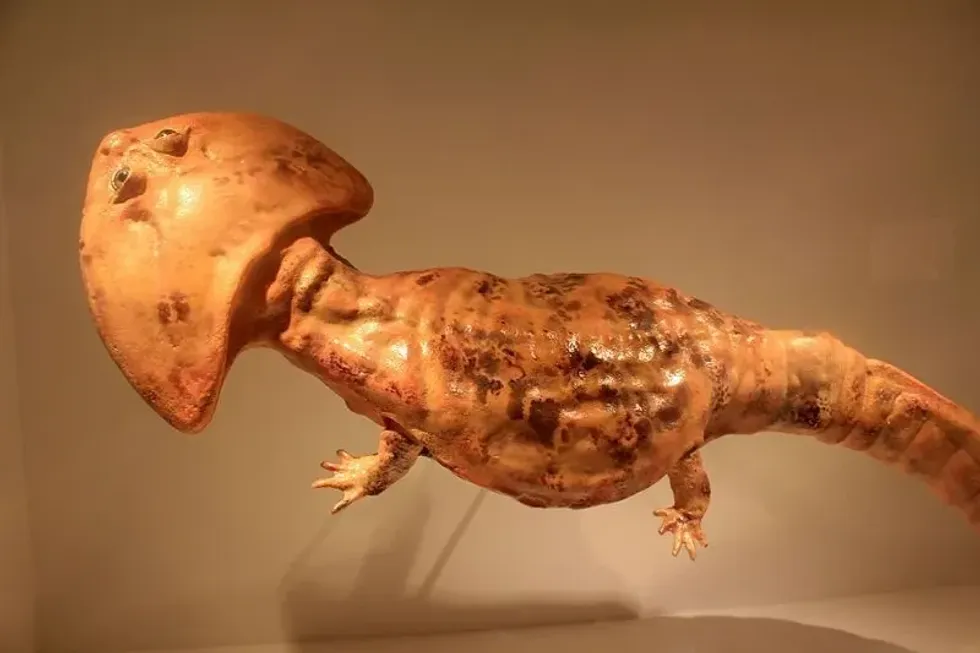Against the backdrop of the dry, rocky desert in southern California, one can notice the banded rock lizard (Petrosaurus mearnsi) scurrying between the boulders at tremendous speed. This olive green lizard is known for its dark, thick bands running around its body, effectively helping to camouflage it against the dusty rocks.
Belonging to the genus Petrosaurus, a genus of California rock lizards, this lizard is quite adept when it comes to climbing and can be found scaling even the steepest cliffs with ease. This lizard can be found running around during the day and resting along the canyon depths, or hiding out in rocky crevices at night.
To find out more about this fantastic lizard, read on! For more relatable content, check out these caiman lizard facts and lava lizard facts for kids.
Banded Rock Lizard Interesting Facts
What type of animal is a banded rock lizard?
The banded rock lizard (Petrosaurus mearnsi) is a type of lizard which is a native species of the western region of North America.
What class of animal does a banded rock lizard belong to?
The banded rock lizard (Petrosaurus mearnsi) belongs to the class Reptilia.
How many banded rock lizards are there in the world?
We do not know the exact number of how many of these reptiles exist in the world, however as their status is of Least Concern, we can assume that their population is estimated to exceed 10,000 individuals.
Where does a banded rock lizard live?
This lizard species can be found scurrying among canyons and sunning itself on boulders in hilly areas. It is also commonly found in deserts, palm oases, and being an excellent climber, this lizard can be seen around high rocky cliffs too.
What is a banded rock lizard's habitat?
The banded rock lizard (Petrosaurus mearnsi) can be found in southern California, America, and in Baja California, Mexico. It is mostly observed in rocky terrains with a dry, humid atmosphere which is its natural habitat. This lizard loves hiding in crevices during cold temperatures and can be seen darting among boulders when the sun is out.
Who do banded rock lizards live with?
These lizards mostly hideout inside rock crevices and in the lower parts of canyons. The banded rock lizard (California lizards) pair up during the breeding season to mate.
How long does a banded rock lizard live?
There is not any information available about how long the lifespan of the banded rock lizard is. However judging from the lifespan of similar rock lizard species, we can assume it is around nine years.
How do they reproduce?
These lizards are oviparous, meaning they give birth to their young by laying eggs. The breeding period for the banded rock lizard lasts from June to August, during which the males and females pair up to mate. The females will then lay around two to six eggs which need to be incubated for two months before they hatch.
What is their conservation status?
The conversation status of the banded rock lizard is Least Concern according to the IUCN Red List.
Banded Rock Lizard Fun Facts
What do banded rock lizards look like?
The banded rock lizard is a medium, flat-bodied lizard that is usually olive, green, or grayish in color, camouflaging it quite effectively. It has rough scales and a black 'collar' around its neck, with wavy black bands encircling its torso all the way down to its tail.
It also has white and blue spots. Its tail is long and thin with thicker black bands.
Its flat feet and toes help it to scurry over the rocks at high speed and dart up hills with ease. Males usually have brighter spots than females and more distinct throat patterns.

How cute are they?
These flat-bodied lizards have been described as quite cute. They are naturally curious lizards but shy if approached.
How do they communicate?
Lizards communicate by a range of means, mostly using chemical secretions in order to relay their different moods to their fellow lizards. They secrete and spread these liquids over their territory which are then 'read' by others and interpreted.
This species will also bob their heads up and down when threatened or their territory is encroached upon in an attempt to scare away intruders.
How big is a banded rock lizard?
The banded rock lizard on average can measure from 2.6-4.2 in (6.6-10.6 cm) from head to vent. Along with its tail, this lizard species is almost 1 ft (30.5 cm) in length. They are in the same range as Texas horned lizards and 10 times smaller than the blue-tongued skink.
How fast can a banded rock lizard move?
These California dwelling lizards are very fast and can be seen darting around among rocky boulders. They are also excellent climbers and can easily scale even seemingly vertical cliff faces, which are common in their native habitat.
How much does a banded rock lizard weigh?
We currently do not have much information on how much this species of lizard ranges in weight.
What are the male and female names of the species?
There are no specific names for either sex of this species.
What would you call a baby banded rock lizard?
Baby banded rock lizards are called hatchlings or neonates.
What do they eat?
Banded rock lizards are omnivorous in nature, mostly feeding on insects, ants, flies, spiders, caterpillars, and occasionally other small lizards. They are also fond of blooming buds or flowers, depending on their habitat.
Are they poisonous?
No, these lizards are not poisonous, however other species of rock lizards may be.
Would they make a good pet?
These lizards are better suited to live out in the wild. They require their space as they are constantly running, skittering up cliffs, and hiding in crevices.
If kept as pets, the temperature and conditions would have to be adjusted in order to make this lizard comfortable and a roomy tank would be needed in order to give them their space. They are quite friendly lizards and will not attack if approached, rather hiding if they feel threatened.
Did you know...
They are diurnal, meaning they are active during the day and asleep at night.
The banded rock lizard (Petrosaurus mearnsi) is named after the American naturalist Edgar Alexander Mearns, by whom it was first discovered.
This banded lizard may also range in woodlands in Baja California, Mexico.
Where are banded rock lizards native to?
The banded rock lizard is an endemic species with a range in southern California in America, and Baja California in Mexico. This lizard can be found in dry, arid conditions.
How did the banded rock lizard get its name?
This lizard is named due to the dark, distinct bands around its body. As it is commonly found in rocky, arid areas, it has rightly been named the banded rock lizard.
Here at Kidadl, we have carefully created lots of interesting family-friendly animal facts for everyone to discover! Learn more about some other reptiles from our sand lizard surprising facts and frilled lizard fun facts pages.
You can even occupy yourself at home by coloring in one of our free printable banded rock lizard coloring pages.








